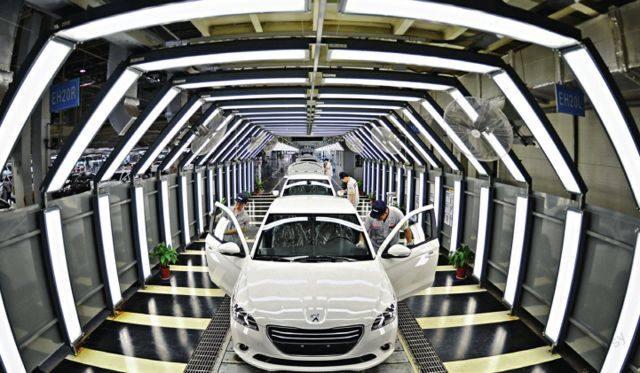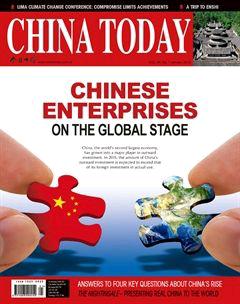Market Economy under the Rule of Law
By staff reporter ZHOU LIN


ALONG with deepened reforms and anti-corruption actions such as the Fox Hunt 2014 campaign, Chinas economy has entered a “new normal.” The concept of governance according to law was raised once more at the Fourth Plenary Session of the 18th Central Committee of the Communist Party of China (CPC) last October. It signifies that the rule of law will govern the future sound development of the Chinese economy.
The Rule of Law, a Boost to Chinas Economy
The Chinese government revealed core economic data two days before the closing ceremony of the Fourth Plenary Session of the 18th CPC Central Committee which included the record low growth figure of 7.3 percent for the third quarter of 2014. This signifies a new challenge for Chinese economy that means bidding farewell its erstwhile mega economic development speed and accepting medium and high growth as the “new normal.” At this decisive stage of deepening reform and building a moderately prosperous society, how to unleash the “dividends” brought by the rule of law as an auxiliary boost towards steadily upgrading Chinas economy has become the focus of all social sectors.
The rule of law is the hallmark of a market economy, and also the basis of the modern state system of governance. The focus of the Fourth Plenary Session of the 18th CPC Central Committee on Chinas rule of law signaled a new era of governing the economy according to law. Experts point out that promoting rule of law reforms will have positive impact on the economy and business, and that Chinas future anti-corruption activities will also promote reforms to its economic structure.
So what are the challenges that Chinas rule of law reform must meet in order to achieve stable and sustainable economic development?
Professor Xu Chenggang of the School of Economics and Finance at the University of Hong Kong believes that the constitutional governance system is the basis of development for financial markets. Chinas biggest challenge, however, is that it has never had private laws, while the market economy is one governed by law. China, therefore, in order to transform its economic growth mode and achieve modernization of state governance, has to build a new order of rule by law, to clarify as a matter of urgency the boundaries between government and market, protect private rights and constrain public power.
Professor Xu has moreover pointed out that Chinas current reform has entered deep waters wherein development is geared to the rule of law and the establishment of a governance system in line with the Constitution. This reform cannot be restricted to the minutiae of contract law, company law, insolvency law, financial law, etc., which although necessary are far from enough. To sustain long-term, sustainable and stable economic development, Chinas law reform must tackle the problem of its absence of private laws. It must protect the independent operation of private law by establishing governance according to the Constitution.
New Order of Law-based Governance
Constraining the power of all levels of government to violate private property rights is at the very core of constitutional governance and judicial independence. Constitutional governance is the cornerstone not only of democracy and the legal system but also of sound economic and financial development.
Premier Li Keqiang has repeatedly emphasized the need to streamline administration and delegate power, highlighting the principles of market economy, wherein items that do not appear on the list of government powers are deemed not permissible; items that do not appear on the negative list which defines areas off-limits to businesses are deemed permissible; and all items on the list of government responsibilities must be fulfilled. We can only thus ensure efficient operation of the market economy.
The future positioning of government actually entails exchanging the omnipotent government of the planned economy era for a service-oriented government – a regulatory government under the rule of law that shoulders its responsibilities. The key lies in placing power within the domain of the rule of law.
Yan Qingmin, vice chairman of the China Banking Regulatory Commission(CBRC), summarized this move in three steps: first, streamline the administrative license in order to supervise and strictly constrain governmental regulatory behavior to within the legal framework; second, authorize provincial and subordinate regulatory agencies to carry out administrative examinations and approvals; third, repeal, delete and standardize administrative power to make it more transparent and uniform.
Chen Wenhui, vice chairman of China Insurance Regulatory Commission (CIRC), confirmed that the CIRC is proactively promoting marketization reform by delegating power, for example, by reducing advance administrative examinations and approvals and transferring management rights to market entities, so strengthening insurance innovation. In 2012, the CIRC dramatically expanded the domain and scale of insurance investment. The system of investment product regulation has also changed from examination and approval to registration. The past two years have thus witnessed remarkable reform achievements.
Challenges to Financial Innovation and Regulation
President Xi Jinping said during the 2014 APEC Economic Leaders Week in Beijing that if innovation was the new engine of Chinas development, then reform is its ignition. In the past 30-plus years, financial innovation in China has promoted reforms of national banks and state-owned enterprises and gradually formed an investment and financing mechanism in line with the market. This has resulted in the establishment and development of a capital market amid the transition of the national economy. It has also enriched and perfected Chinas financial system and products. At present, the new economy as represented by the Internet has totally overturned the traditional industrial and financial mode and invigorated the financial market. It has moreover broken the barriers of administrative monopoly, so pushing the government to change its regulatory model and vitalize ongoing reforms.
Zhuang Xinyi, vice chairman of China Securities Regulatory Commission (CSRC), listed the characteristics of financial innovation in the new era: first, as innovation accelerates, new mechanisms and products steadily appear; second, innovation is not limited to a certain market or industry, and growing cross-market financial products have expanded connectivity among different markets and industries; third, the growing combinations and complexity of financial tools have been greatly enhanced, and individual services offered to real economy bodies.
Chen Wenhui raised the latest financial innovation data. Chinas Internet insurance revenue rose from RMB 31.8 billion in 2013 to RMB 62.2 billion during the first three quarters of 2014– an increase of 195 percent over the total 2013 figure. During the “Double Eleventh Day” (November 11) shopping spree of 2013, the return transportation insurance turnover exceeded 150 million units, earning a world record RMB 90 million. The 2014 Double Eleventh Day saw a new high of 186 million units of return transportation insurance, which translates to a new world record RMB 100 million.
In his remarks on changes the Internet has wrought on the financial market, Yan Qingmin, vice chairman of CBRC, recommended tolerance and a tacit consent to this new phenomenon, as long as it does not pose any regional risk or infringement of CBRC regulations. Since Internet finance began to sprout in China, CBRC has made careful observations and formulated with other related ministries and commissions certain regulations. Yan gave some advice on the supervision: first, appropriate regulation that avoids subjective assumptions; second, coordinated supervision, taking into consideration a large number of cross-industry financial products, which entail supervision of different departments; and third, innovations to the regulatory model.
In 2003, with the establishment of CBRC, Chinas financial regulatory system took shape, with three regulatory bodies, comprising CSRC, CIRC, and CBRC as well as the Peoples Bank of China (Chinas central bank), responsible for supervising different fields. However, the changing financial market and emerging cross-industry financial products and operations pose new challenge to the existing regulatory system. Yan pointed out that better coordination among different regulatory organizations is necessary in order to avoid regulatory gaps and consequent inefficiencies that could obstruct future financial industry development. Yan emphasized that supervision, industry, monetary, and fiscal policies should be interconnected.
Encouraging financial innovation, however, does not mean that there is no bottomline to financial regulation. Regulators agree that they should not only support financial innovation, but also maintain a basic financial order to obviate systematic or regional risk while safeguarding the principles of openness, justice, and fairness. Premier Li Keqiang once said that all items on the list of government responsibilities should be fulfilled. Guarding against financial risk is the lawful responsibility of financial regulatory agencies, and sticking to that bottomline is the acknowledged boundary of financial innovation.

